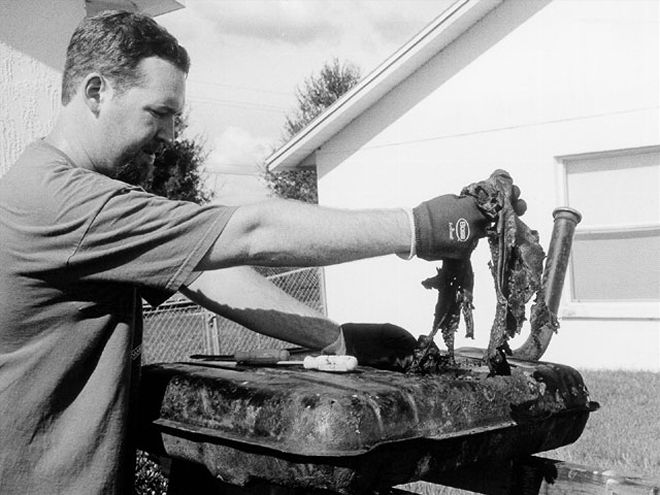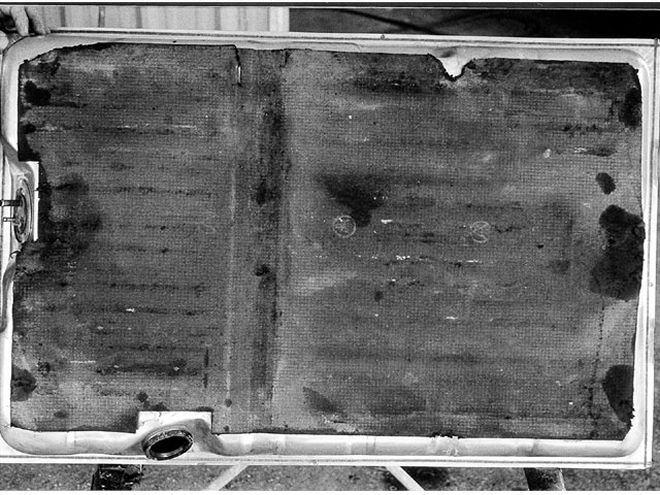

We're tooling over to Tampa, crossing the bay on the Sunshine Skyway bridge in the wife's '50s car on a beautiful Sunday afternoon. We're on our way to a nephew's second birthday party, and we've got the full compliment of family members aboard-wife, young 'un, and mom-in-law, just to make things perfect. Everything's fine until we get to about the middle of the bridge and the car starts chugging. We've done this dance before, so at the first sign of a problem we started angling for the shoulder, more out of reflex than anything else.
We can now tell you, first hand, that the Skyway Bridge in Tampa, Florida, sways from side to side about a foot or two on center. Even on a relatively calm day. Did we mention that we're also not real fond of unstable heights?
Up until then, the car ran fine. It'd made the do-si-do to and from work more times than we can count. It'd been to Tampa twice before, and even made the nearly three hundred mile round trip to Daytona Beach and back. Never a problem. That's because we didn't have the mother-in-law along for any of those cruises.
The car got to the party, eventually (and we do mean eventually). It finally got back home under its own power, too. But now the wife refers to it as The SS Minnow (think "three hour tour"), and I'm stuck driving it because she doesn't trust it. That's not all bad, but I'd really like her to be driving a vintage car on a daily basis.
We've done more than our share of little roadside repairs on the car, both before and after what's since become known simply as "That Day on the Bridge." All have been the usual things one would expect from a vintage car, and none have been a big deal. But we've got to admit we were blind-sided by what shouldered us that day on the bridge-it was the gas tank.
Purchased from the second owner, the car had only 25,000 miles on the clock when we added our name to the title. The seller told us he'd drained the gas tank and rebuilt the carb, and it ran pretty well during the test drive. After trailering it home, we did a quick inspection of what needed to be addressed for road worthiness, made the fixes, and started driving.
Learn from our mistake.
After driving the car for a couple of months, the tank started leaking a little bit. Pin holes in vintage tanks are common, so we dropped the tank to make what we thought would be an easy repair. Thanks to the EPA, it's hard to find a shop that will "boil out" a gas tank, so not being of the nature to let a little environmental catastrophe stand in our way, we proceeded to clean out the tank in our own driveway with several gallons of muratic acid. What fun that was.
The sediment we removed from the gas tank can best be described as scary. We're not sure what it was, but there was several pounds of it, and it had the consistency of Silly Putty gone bad. It came out in chunks and sheets, the biggest of which weighed about a pound. We pulled it all out of the sending unit hole in the top of the tank with a screwdriver and a mechanic's retrieval tool, both of which died because of the acid.
 The original pad between the tank and the trunk floor was in excellent condition. It was carefully removed from the old tank and glued to the top of the reproduction tank. A wide-blade gasket scraper will make removal easy. If yours is beyond saving, reproductions are available.
The original pad between the tank and the trunk floor was in excellent condition. It was carefully removed from the old tank and glued to the top of the reproduction tank. A wide-blade gasket scraper will make removal easy. If yours is beyond saving, reproductions are available.
Then we put a do-it-yourself gas tank repair kit in and re-installed the tank, thinking we were good to go. And we were-for six weeks. Then the baffles in the tank inexplicably detached (probably from the acid we'd immersed them in for a day) and started sloshing around, scraping up the repair stuff we'd coated the inside of the tank with. The repair stuff then got sucked into the fuel line and, well, the nightmare just wouldn't end. We ended up doing what we should have done in the first place-we bought a new gas tank. But not before the car lost any image of reliability it once had, due to the fuel lines plugging and stalling the car regularly.
On the Paddock Project '69 Charger, Mike Peramski immediately made the decision to just replace the gas tank in the Charger with a brand new reproduction, even though the car ran fine and had low mileage. While he was replacing the gas tank, he also made the decision to replace the fuel lines at the same time.
You never know what's inside your fuel lines. Besides gas tank debris, fuel lines often have rust and scale in them which will plug your fuel filter as it comes free, now that you're running gas through the system on a regular basis.
We cut the Charger's original gas tank open, just to see what was inside, and found about an inch of hardened crud at the bottom of the tank. However, the tank had been emptied for quite a while and stored outside, allowing the deposits to dry and "set up." We suspect that the stuff in the bottom of that tank was probably soft when immersed in gasoline (much like what we pulled out of the wife's car), which could let it find its way to the fuel pick up, and then to the filter.
Reproduction gas tanks aren't available for all makes and models, but take it from us-if you can get a new tank for your car, do it. Even if you've never had a problem before, it's cheap insurance, because you never know what might be swimming around in your tank now. And believe us, if it's going to leave you stranded, it'll pick the worst time and the worst location to do it!